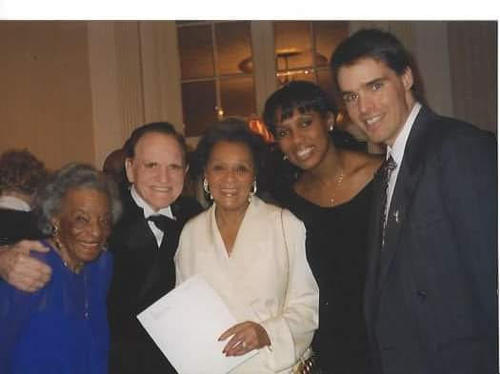 The 1988 Jesse Owens Awards Dinner: Left to right: Ruth Owens, 2-time Olympic PV gold Medalist Bob Richards, the Owen’s daughters-Gloria and Marlene, and Jeff Benjamin
The 1988 Jesse Owens Awards Dinner: Left to right: Ruth Owens, 2-time Olympic PV gold Medalist Bob Richards, the Owen’s daughters-Gloria and Marlene, and Jeff Benjamin
Jeff Benjamin and I are kindred spirits. That is why Jeff has put up with me for the past three decades. That, and that we both love our sport and have an immense appreciation for history.
Jeff wrote the following review of the move, “Race”. But his piece is also a thoughtful reminder of how important understanding history is in everyday life.
Jesse Owens was a man of some complication. Anyone who lives over the age of 40 has some complication in their life. Successes and Failures. One learns more from the failures, but they are hellacious to surive. Raised in a time in this country when racism was even more outright than it is now, Owens juggled mine fields each and every day. In the 1936 Olympics, Owens did challenge the Nazi philosophy of Aryan superiority, but so did the performances of twelve other fine African-American athletes. Avery Brundage, the USOC head was, at the very least, an admirer of the Nazi regime, and at the worst, shares a place in hell where the worst hypocrites are housed. Brundage did change the 4x100m team, taking off two fine American sprinters, due to the fact that they were Jewish.
Brundage was credited with standing up to Hitler and the Nazis. Nothing could be further from the truth. It was Henri de Baillet-Latour, IOC President (1925-1942), who threatened Hilter with moving the Olympics due to the Nazi treatment of Jews and Gays in particular. Baillet-Latour was a tough gentleman who knew that Hilter saw the Olympics as legitimazation for his regime. He has never, in my mind, recieved the respect he deserved.
Jim Crow laws were in effect in the 1930s. Heck, they were in effect in the 1950s. Separate facilities for African-Americans, and whites. Jesse Owens might be a global sports hero, but upon his return to the U.S., he was treated second class, like most of his African-American brothers and sisters. It is not pretty, but it is a fact. I wonder how the late Jesse Owens would look on the terrible things that happened in Ferguson, Missouri last year. I am not sure how much has changed in much of this country.
To me, that is one of the wonders of track & field. The most diverse sport in high schools in North America, one learns how to work with others. If one makes a relay team, those members become your brothers and sisters. After running a 4x100m or a 4x400m, racism becomes quite antiquated and quite sad. The truth was, Adolf Hilter feared America because of our diversity, he referred to Americans as a “mixed horde”. Think about that for a moment.
One wonders how Jesse Owens differentiated the Nazi philosophies of Aryan superiority over the American mixed race, as the Nazi’s called them, and how he was treated upon his return to the US. I do not know. This would be one of the many questions I would like to ask him.
I do recall an interview with the mother of Carl Lewis, who told me about her experiences as an African-American women athlete in the 1950s in Ohio. The hotels for African-American athletes were of lesser quality than for white athletes and it was disconcerting for her.
I hope that many see the movie. I think, overall, there are some good things for young kids to see in the movie. Leni Reifensthal, the Nazi movie director, used her charm and grace to make movies, with the support of Josef Goebbels and admiration of Adolf Hilter. Whether she was a Nazi or not went to her grave with her. “Triumph of the Will” a movie that celebrates the Nazi Nurnberg rallies is a must see for history and movie fans, as is her 1936 Olympic movie. Judging whether they are evil personified is up to the viewer.
It is a fact, that in December 1941, 71 percent of Americans supported the America First movement, head by the late Charles Lindbergh. This group was convinced that we should stay out of the coming World War, due to the supposed strenght of the Nazi military, thanks to the propaganda efforts and schmoozing of Herr Goebbels, a man who understood good PR. Did Goebbels and Hitler pressure Brundage into changing the 4x100m relay at the last minute? Again, study the times, and decide for yourself.
The movie should be seen in the context it was made: a story trying to capture the man, Jesse Owens, and the times. Did they do that?
Again, dear reader, that is up to the viewer!
Enjoy Jeff Benjamin’s review.
Jesse Owens “Race” Movie Review
By Jeff Benjamin
One of the sad facts in education today is that during the last decade the powers that be have asserted a policy for schoolchildren throughout the nation that has culminated in the emphasis on testing. Although in recent years education is moving away from that emphasis, the generation of kids that have been affected by these policies has lost out on the teaching of certain figures in history. Rather than learn about the person who made their indelible mark on society, along with their challenges, pressures and beliefs which all have had, kids were given just general concise facts. Sadly, this led to less empathy on the side of children towards these figures and even some figures being, say, shuffled off to the side.
For whatever reason, Jesse Owens fell into the shuffle category in recent years. A figure who was taught alongside so many other important figures for decades, his rise and exploits at the 1936 Berlin Olympics in Nazi Germany have seemed to recede from the minds of our current crop of kids. Thankfully, Focus Features, along with Director
Stephen Hopkins, have brought perhaps our greatest Olympian
back to the forefront, with Stephan James portraying Owens in the current film, “Race” which was released, hopefully to coincide with Black History Month.
The film totally focuses on Owens during his incredible athletic years from 1932-1936, when the son of a sharecropping family went to Ohio State to compete under the watchful, firm and guiding eye of legendary coach Harry Snyder. Snyder, played by Jason Sudeikis, comes across as a brilliant technical coach for his era, as well as a motivator. Snyder eats sprinting, but drinks alcohol quite often, a possible byproduct of his failure in 1924 as a promising Olympian himself. While not a perfect person, he treats the Buckeye Owens as he would any other athlete, despite the specter of racism and segregation which is consistently evident throughout the film.
Owens’ rise in the athletic world, along with his performances here in America, are shown using the modern technology of the movie world, and these moments are truly wonderful. But it’s also the acting of James,
who almost always tries to show self-control and the professionalism that the real Owens was said to possess during these turbulent years, which makes one root for him.
Not to say that Owens was perfect either. Co-parentjng a daughter with his girlfriend Ruth Solomon (later Owens, played by Shanice Banton ) shows some missteps along the way in his steady rise to stardom. But it is also Banton who truly shines in portraying Ruth as the rock which will eventually steady Jesse.
The politics of the times are on full display as well, although 3 of the major characters in this episode are portrayed quite subtly. With Jeremy Irons as USOC leader Avery Brundage, Carice Van Houten as Nazi Film Director Leni Riefenstahl, and Barnaby Metschurat, as Hitler’s disciplined and calculating Propaganda Minister Josef Goebbbels, the film leaves out more than meets the eyes in regards to their possible interactions during this period, which is difficult to do in any Hollywood historical piece.
Which brings up the never ending question regarding a historical Hollywood production-How accurate is this film? Yes, the USOC did vote on whether to boycott the Berlin Games and Owens did face the pressure of not going to Berlin but did his great rival, the star-crossed Eulace Peacock (played by Shamier Anderson) truly encourage him to go? I don’t know the answer to that one. But Yes, German Long Jumper Luz Long ( played by David Kross) did help Owens out in a great display of sportsmanship when he almost fouled out of the competition, but perhaps not in the way it was shown in the film. And Yes, American Relay runners Sam Stoller ( Giacomo Gianniati) and Marty Glickman ( Jeremy Ferdman) were replaced at the last minute by Owens and Ralph Metcalfe (Dondre Octave) under the orders of Brundage. But was it because they were the only 2 Jewish athletes on the team and Goebbels mentioned it to Brundage quite menacingly? Well, that gets kind of murky but one can possibly connect the dots.
However, one does not need to convince viewers of the spirit and impact of Jesse Owens performance in 1936. If anything, this film will hope to resonate with our list generation of youth, who never had the great opportunity to learn about him and his inspiring story.
Postscript- while the filmmakers did present an excellent epilogue to the characters in the film, I was surprised to see nothing was mentioned about Ruth Owens. Not only in film but in life, this woman showed a solid resiliency as evidenced by her passing away at the age of 86 back in 2001 more than 20 years after her husband had passed, keeping their legacies secure in the minds of many.
Author
-

Jeff Benjamin has written for 30 years for American Track and Field along with RunBlogRun. The Former President of the Staten Island AC & Chair of the Staten Island Running Association was the 5th man scorer for his Susan Wagner High School NYC XC City Championship team. Also a member of the College of Staten Island Sports Hall of Fame for XC, Jeff currently serves as the LDR Chairman for USATF NY. A passionate (or fanatical) follower of the Sport, some of Jeff's subjects have included Sebastian Coe, Emma Coburn, Eamonn Coghlan, Matt Centrowitz, Jim Spivey, Galen Rupp, Joe Newton, Tom Fleming, Ajee’ Wilson, Bill Rodgers, Allan Webb, Abel Kiviat, Jordan Hassay, Marty Liquori, Caster Semenya, Rod Dixon, Carl Lewis and Jim Ryun as well as Book Reviews and articles covering meets and races in the Northeast U.S.
View all posts





















